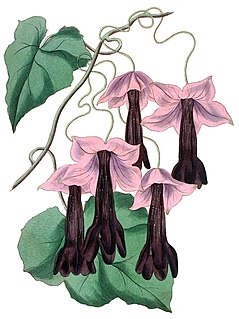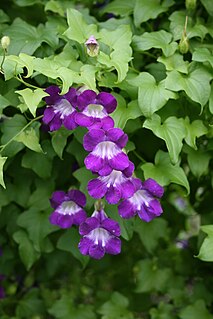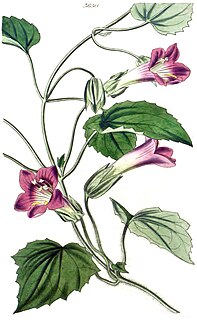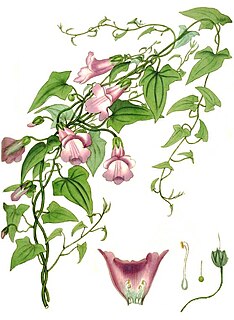
Rhodochiton is a genus of flowering plants within the family Plantaginaceae, native to southern Mexico and neighbouring Guatemala. They climb by means of twining leaf stalks. One of the three species, Rhodochiton atrosanguineus, the purple bell vine, is grown as an ornamental plant. All three species are sometimes included in Lophospermum.

Lophospermum is a genus of herbaceous perennial climbers or scramblers, native to mountainous regions of Mexico and Guatemala. Those that climb use twining leaf stalks. Their flowers are tubular, in shades of red, violet and purple, the larger flowers being pollinated by hummingbirds. Now placed in the greatly expanded family Plantaginaceae, the genus was traditionally placed in the Scrophulariaceae. The close relationship with some other genera, particularly Maurandya and Rhodochiton, has led to confusion over the names of some species.

Maurandya is a genus of flowering plants in the family Plantaginaceae, native to Mexico and the south west United States. They sprawl or climb by means of twining leaf stalks. One of the four species, Maurandya barclayana, is widely cultivated as an ornamental plant.

Holmgrenanthe petrophila is a rare perennial desert plant in the plantain family (Plantaginaceae), and the sole species of the genus Holmgrenanthe. It forms low mats of branched stems growing from a woody base. The leaves have small spines along their edges. The solitary yellow flowers are tubular with five free lobes at the end, the upper two pointing backwards, the lower three projecting forwards. The species is known only from about ten locations, most in the Titus Canyon and the adjacent Fall Canyon, all within the Californian section of Death Valley National Park. It grows in limestone crevices on the canyon walls, often on the north face.

Lophospermum scandens is a scambling or climbing herbaceous perennial native to south central Mexico, with red-violet and white tubular flowers and toothed heart-shaped leaves. It grows at elevations between 1,400 and 2,400 m in dry habitats, including deciduous oak forests and recent lava flows. The long-tubed flowers are pollinated by hummingbirds. It has been used in gardens as an ornamental plant since the mid-19th century. Its roots require protection from frost in regions where this occurs in the winter. Hybrids of L. scandens are also grown.

Rhodochiton atrosanguineus is a herbaceous perennial vine native to Mexico. It has been cultivated as an ornamental plant since at least 1836.

Mabrya is a genus of flowering plants in the plantain family, Plantaginaceae. It consists of herbaceous perennials with brittle upright or drooping stems, found in dry areas of Mexico and the southern United States.

Maurandya scandens is a climbing herbaceous perennial native to Mexico, with pink and white tubular flowers and untoothed leaves. It is grown as an ornamental plant in many parts of the world, and has commonly escaped from cultivation to become naturalized. It has been confused with Lophospermum scandens, which has longer flowers and larger, toothed leaves. It resembles Maurandya barclayana, which has blue-violet flowers and hairy rather than hairless sepals.

Lophospermum purpusii is a scambling or climbing herbaceous perennial native to Mexico. It has tubular flowers, white at the base and red to violet elsewhere.
Rhodochiton nubicola is a climbing or sprawling herbaceous perennial native to the state of Chiapas in Mexico and to Guatemala, where it grows in cloud forests at between 1,300 and 3,000 m. It has dangling flowers, with a bell-shaped calyx and dark purple petals forming a tube. Unlike the better known Rhodochiton atrosanguineus, the petal tube is asymmetrical with two "lips".
Lophospermum breedlovei is a climbing or scrambling herbaceous perennial native only to the state of Chiapas in Mexico. It has tubular flowers, white at the base and dark purple elsewhere. It was first described by Wayne J. Elisens in 1985. The epithet breedlovei commemorates Dennis E. Breedlove, described as a "prolific plant collector and authority on the flora of Chiapas".
Lophospermum chiapense is a climbing or scrambling herbaceous perennial known only from one location in the state of Chiapas in Mexico, where it was first collected. It has tubular flowers, white at the base and violet elsewhere. It was first described by Wayne J. Elisens in 1985. The epithet chiapense refers to its place of collection.
Lophospermum turneri is a climbing or scrambling herbaceous perennial native to Guatemala and the state of Chiapas in Mexico, where it was first collected. It has tubular flowers, lavender to violet in colour. It was first described by Wayne J. Elisens in 1985. The epithet turneri commemorates Billie L. Turner, described as "mentor of many students of the Latin American flora".
Lophospermum purpurascens is a climbing or scrambling herbaceous perennial native to Mexico, occurring in the states of Oaxaca, Veracruz and possibly Puebla. It has tubular flowers, white at the base and dark purple elsewhere. It was first described by Wayne J. Elisens in 1985. The epithet purpurascens means purplish or becoming purple.

Mabrya acerifolia, or brittlestem, is a mat-forming herbaceous perennial native to south-central Arizona. It has pale yellow tubular flowers. It was first described by Francis W. Pennell in 1924 in the genus Maurandya and transferred to Mabrya by Wayne J. Elisens in 1985. The epithet acerifolia refers to the somewhat maple-like shape of its leaves.
Mabrya geniculata is a mat-forming herbaceous perennial native to the Mexican states of Sonora and Chihuahua. It has pale yellow tubular flowers. It was first described in 1894 by Benjamin L. Robinson and Merritt L. Fernald in the genus Maurandya and transferred to Mabrya by Wayne J. Elisens in 1985.
Mabrya flaviflora is a mat-forming herbaceous perennial native to a small area in Baja California Norte, Mexico. It has pale yellow tubular flowers. It was first described by Ivan M. Johnston in 1924 in the genus Maurandya and transferred to Mabrya by Wayne J. Elisens in 1985 as Mabrya geniculata subsp. flaviflora. It was restored to a full species within Mabrya by David A. Sutton in 1988. The epithet flaviflora means yellow-flowered.
Mabrya coccinea is a mat-forming herbaceous perennial native to the Mexican state of Coahuila. It has red tubular flowers. It was first described by Ivan M. Johnston in 1950 in the genus Maurandya and transferred to Mabrya by Wayne J. Elisens in 1985. The epithet coccinea means red.
Mabrya rosei is a mat-forming herbaceous perennial native to the Mexican states of Jalisco and Zacatecas. It has tubular flowers, whitish at the base and red to red-violet at the apex. It was first described by Philip A. Munz in 1926 in the genus Maurandya and transferred to Mabrya by Wayne J. Elisens in 1985. Munz did not explain the origin of the epithet rosei but listed the collector of the type specimen as Joseph Nelson Rose.
Mabrya erecta is an upright herbaceous perennial native to Mexico – the states of Chihuahua, Coahuila, Durango, Nuevo León and possibly México. Unlike other members of the genus Mabrya, it does not form mats. It has tubular flowers, whitish at the base and pink to red-violet at the apex. It was first described by William B. Hemsley in 1882 in the genus Maurandya and transferred to Mabrya by Wayne J. Elisens in 1985. The epithet erecta means erect or upright.








